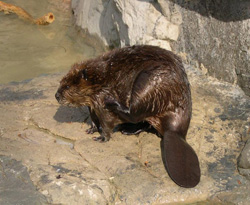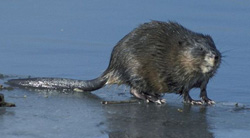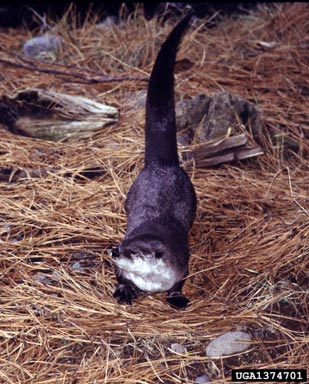Beavers, Muskrats, and Otters are aquatic mammals whose ranges cover most or all of South Carolina, so there is potential for almost any pond in the state to harbor these fur-bearing animals. Although interesting to watch, these animals can be problematic when they move into stormwater ponds. It is important to be able to identify each animal to determine the potential for damage, because these three mammals have different behaviors and cause different kinds of damage. Early morning hours are the most likely time to catch a sighting of these animals. Otherwise they may be identified by evidence of their activity.
How can these animals be distinguished from one another?
-
Beavers (Castor canadensis)
Beavers ( Castor canadensis) are the largest of the three species (40 to 60 lbs) and also are the slowest swimmers. They have large, leathery, paddle-like tails that they use in several ways, the most indicative of which is slapping the water surface when disturbed. All toes are webbed which can be evident in tracks around the pond. Beaver are probably best identified by the work they do and the damage they cause. Beavers often girdle trees and shrubs around the pond, they block pipes and the outfall with sticks, logs, and mud, and they construct wood and earthen dens or burrows into the bank. It is recommended that beavers be removed from stormwater ponds because of the property damage they cause, the potential for flooding, and the destabilization of the bank.

-
Muskrats (Ondatra zibethicus)
Muskrats (Ondatra zibethicus) are the smallest of the three species (2 to 4 lbs) and are moderate swimmers. They are distinguishable from beavers by their smaller size and the characteristics of the tail and feet. Muskrats have a tail that is flattened vertically (the opposite of the beaver) and is longer and more "rat-like". Their feet have skin folds between the toes but not the extensive webbing that beavers have. Muskrats are not as damaging as beavers because they do not block pipes and outfalls with sticks and mud. Muskrats may girdle trees and shrubs and eat other landscape plants, but their most significant damage is caused by the burrows they build in the bank slope. These burrows can undermine bank stability and are especially problematic for ponds that are held in place by earthen dams. The burrows can breech the dam causing washouts, water loss, and downstream flooding. It is recommended that muskrats be removed from stormwater ponds.

-
River Otters (Lontra canadensis)
River Otters ( Lontra canadensis) are easily distinguished from beavers and muskrats by several characteristics. Otters are longer and leaner, they are agile, fast swimmers, and they have long, round tails that are covered in fur. They have sharp, predatory teeth. Otters are more vocal than beavers and muskrats, letting out the occasional yelp or bark. Otters also can be identified by the evidence they leave behind. Otters tend to enter and leave ponds in the same place, which over time creates a worn area known as an otter slide. Otters also tend to dine on the fish they have caught on the bank in the same area, so there may be an area beside the pond that is riddled with fish bones and scales. River otters do not pose a significant threat to property, pets or humans. The most significant problem they cause is consumption of fish. If your community has stocked triploid grass carp, otters may remove them from the pond. Many residents regard otters as desirable animals because of their playfulness and curiosity. It is recommended that they community determine for itself, if otters are to be allowed to remain in the pond. Aside from depleting fish populations, they are unlikely to cause other problems.

-
How are these animals controlled?
South Carolina regards all of these animals as furbearing species, which are protected under state law. A license is required to trap, dispatch, and transport these animals. Contact your local wildlife office of the SC Department of Natural Resources for guidance on removing these animals.
Wildlife Section Offices with SC DNR
- Charleston (843) 953-5291
- Clemson (864) 654-1671
- Columbia (803) 734-3886
- Florence (843) 661-4766
Also, you may contact a licensed Nuisance Wildlife Control Operator to have them trapped and removed for a fee. Consult the Nuisance Wildlife Control Operators list to find an operator near you.

